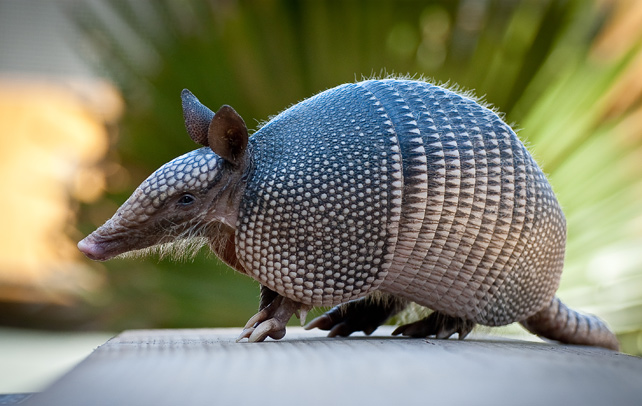Interesting Fun Facts About Armadillos

Armadillos are small mammals and are mostly found in South America and central parts of the United States. Armadillo is a Spanish word which means “little armoured one” because of its tiny appearance. During times of danger, the strength of their outer shell enables them to run fast in the forest, without getting hurt. Armadillos are closely related to sloth and anteater, which belong to the Dasypodidae family. These mammals are found in 20 different breeds and each breed is named according to its physical characteristics. Some of the breeds include, the nine-banded armadillo, giant armadillo, large hairy armadillo, three-banded armadillo, pink fairy armadillo, six-banded armadillo, northern naked-tailed armadillo, and pitchy or dwarf armadillo. They are supposed to have developed from huge, bony-shelled animals called glyptodont and panochthus. Although present day armadillos are small in size as compared to the ancient ones, but they still retain the hard shell of their ancient counterparts. Read on the next section to know some facts about armadillos.
Fast Facts
Scientific Name: Dasypus Novemcinctus
Kingdom: Animalia
Phylum: Chordata
Class: Mammalia
Infraclass: Eutheria
Order: Cingulata
Superorder: Xenarthra
Family: Dasypodidae
Species: 20
Origin: Central and South America
Diet: Omnivorous
Size: 12 cm- 150 cm long (Depending upon species)
Weight: 85 g – 54 kg (Depending upon species)
Natural Habitat: Rain forests, grasslands, and semi-deserts
Lifespan: 12 – 15 years (In captivity)
Sexual Maturity: 9 -12 months
Gestation Period: 60 to 120 days
Number of Offspring: 4
Interesting Fun Facts About Armadillos
- Armadillos are the only mammals which give birth to young quadruplets at one time and from the same egg. These quadruplets are identical in every aspect.
- Armadillos might help in the cure of one of the dreadful chronic diseases, leprosy. The bacterium of leprosy grows in a body with low temperature, which is not found in most of the animals. But, the body temperature of armadillos is low enough to contract the disease. Thus, the scientists are taking the help of armadillos in the anti-leprosy research.
- The outer core of armadillos is so strong that they don’t get hurt when a car runs over them.
- Armadillos are marvellous swimmers. They have a strong dog paddle, and can cover a good distance underwater, walking along the bottom of streams and ponds. When they need to float, they gulp air into their intestines to make themselves more buoyant.
- Armadillos have no teeth enamel covering the hard outer covering of their tooth. This is the reason why the teeth of this tiny creature are not that strong and are fewer in number.
- Just like other insect eating mammals, armadillos have a very long and sticky tongue to slurp up bugs as quickly as possible. They are well-equipped with strong claws to tear open ants’ nests.
- Armadillos have a very low metabolic rate which indicates that they don’t waste a lot of energy producing heat. This also means that they are not good at living in cold areas. They do not have any fat reserves, so they must forage for food on a daily basis. Just a few cold days in a row can be deadly to an armadillo.
- One way they conserve energy is through reta mirabila, a term used in Latin for “miraculous net” which is a system of veins and arteries in their legs. Cold blood coming through the veins cools down the hot blood going out through arteries, and vice-versa; thus, not much heat actually goes out into the legs, keeping it in the body. Therefore, they get no way to warm their outer parts and get frostbitten, thus damaging their skin and other tissues.
- The offspring’s of armadillos have soft shells, like human fingernails. As they grow, the shells get harder by depositing bone under the skin to make a solid shell.
- It is believed that nine-banded armadillo cannot roll itself into a ball to escape predators. Only one of the twenty-odd varieties of armadillos—the three-banded armadillo (Tolypeutes tricinctus), is able to roll up. The other types are covered with too many bony plates to allow them to curl up. Other armadillos have to rely on their armoured shells for defence, which help them to scuttle away through thick and thorny bushes or dig themselves a hole to hide in.









